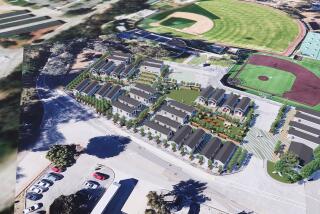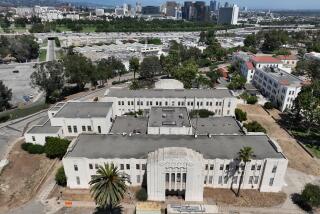A Veteran’s Search for a House to Call Home
- Share via
For about three years, the Calderon family lived in a rented hut. It was shaped like an igloo, and it sat in a village of huts next to Griffith Park.
There were no white picket fences. But here, in 1946, in the middle of one of the city’s worst housing shortages, the Calderons began on a successful path to their own home and business in the suburbs.
“I was there for years before I was able to get out of there and buy my house,” 83-year-old Rudy Calderon said, recalling life in the temporary veterans housing. “I was having a hard time raising the money for the down payment of $1,500.”
Like few other places, Los Angeles has always had the power to lure residents. But for all its rich imagery, life here has sometimes been a study in imbalance: lots of people, lots of hope, not enough avenues to accommodate them all.
This was the story of postwar Los Angeles, a time when the classified section of the paper brimmed with ads from veterans and their families begging to be accepted as renters. This was the Los Angeles that Calderon found in 1946.
Calderon was born and raised in Phoenix, in a family that made its living repairing and making shoes. His father had a shop; so did an uncle. It was a time when making shoes by hand was still common--especially the special-order cowboy boots made by his family.
“When I was a little boy, my uncle used to teach me,” he said. “I used to help him after school.”
During World War II, Calderon was drafted along with his three brothers. When the war was over, Calderon decided to live in Los Angeles.
Many veterans made the same decision after passing through Los Angeles on their way to the war in the Pacific. Having seen the place with their own eyes, and experienced the weather, they too wanted to live here.
But there were not enough houses to go around. Building had stopped during the war, and it would take years before supply would meet the city’s growing demand.
So the government created housing projects like the Roger Young Village, which was on land that would later be the site of the Los Angeles Zoo. About 1,500 veterans and their families lived there, Calderon said.
The homes were Quonset huts, structures made of corrugated metal that had been used to shelter soldiers in the war. The huts were simple and sturdy--like life in the village.
“We had everything there, just like a city,” Calderon recalled. “Griffith Park was our backyard.”
Self-Contained Community
Inside the village were just about all the necessities of life--and a few luxuries. Grocery stores. A barbershop. A beauty shop. A bar. And there was one shoe repair shop--Village Shoe Repair. Rudy Calderon owned it.
All the veterans in the village came to him for repairs or to order shoes. “My business was good,” Calderon said.
Residents did most of their shopping there, and shop owners benefited from the government’s decision to allow only one business of each kind to operate in Roger Young Village.
Some who lived in the village were ashamed, Calderon said, because “they figured they were living on government handouts.”
For Calderon, the attraction was not just the low rents--about $35 a month, including utilities. Most people on the outside couldn’t find a rental--not even a hut. The housing shortage was that bad, he recalled.
Veterans in the village had an advantage compared with other veterans housing projects in Los Angeles.
Some others lived in Army-type barracks, he said. But the elongated huts were divided into two private living quarters, each with two bedrooms, a bathroom, and a combined kitchen and living room area.
Living in the village did not trouble Calderon. “I could have stayed there longer,” he said. His children attended school nearby in Glendale, and the family enjoyed living by the park and observatory.
Looking for the Welcome Mat
By 1950, the Calderons saved enough money to purchase their own home. By then, there were plenty of choices.
The couple decided on the San Fernando Valley. But parts of the Valley in those days were not accepting of Mexican Americans. As they searched for a home, some real estate agents suggested that they “would be happier someplace else.”
“They made all kinds of excuses,” he recalled. “You knew what it was about. They made it rough so you couldn’t get in. That was common. It’s nothing new. You lived with it.”
But, he added, because he was a veteran, sales agents had to eventually accommodate the family.
By the time he settled on a $10,000 home in Pacoima, there were four other Mexican American families in the 80-home tract.
“It was hard for us to get into, and definitely hard for the black people,” Calderon recalled. “There were none sold to any of them.”
Still, Pacoima of the 1950s was small and friendly, he said.
“There weren’t so many buildings,” he said. “Around Mission Cemetery was mostly lemon groves. There was no Holy Cross Hospital. No hospitals at all. It was a rural type of area. I liked that.”
It was a mixed community. There were farms owned by Japanese Americans, and by 1950, retired heavyweight champion Joe Louis had built a 200-acre tract of about 1,000 bungalows in Pacoima, dubbed Valleyview Village. Many remember it as the only Valley community where African American home buyers were welcome in those days.
Those who lived in the community “got along fine,” he said. “We had no problems of any kind, racial or otherwise.”
Like the Valley itself, industry was growing and many veterans found good-paying jobs with employers like Lockheed and General Motors. Calderon got a job at Lockheed.
But the impulse to continue in the footsteps of his father and uncle--to be his own employer--was strong. Before 1950 was over he had scouted out a place for his business, left Lockheed, and opened his shoe repair shop.
He chose Van Nuys Boulevard, which had a steady flow of foot traffic and lots of small mom-and-pop businesses.
Calderon’s business would provide for a family that grew to include nine children.
Among the footwear he repaired over the years were the dress shoes belonging to Primo Carnera, the 6-foot-6, 260-pound boxing great, who was knocked out by Joe Louis in 1935. “They were huge,” Calderon said. He fixed Shirley MacLaine’s heels and repaired the shoes of dancer Ann Miller.
Being a business owner on Van Nuys Boulevard at the time meant being involved in shaping the neighborhood. The Pacoima Chamber of Commerce lobbied for bus service and better street lights and sidewalks.
Those were days of civic action and petitions. Calderon ticks off the names of many business owners who worked to build up the community, as well as their own enterprises. They signed petitions and pushed their elected representatives for street lights, and to replace cesspools with a sewer system.
Residents wanted local schools, and eventually Montague Elementary School was built. For years, neighbors lobbied for a hospital, Calderon said, and in 1957 a tragedy underscored the need.
Longtime community activist Irene Tovar was a student at San Fernando High School the day a plane crashed nearby.
“It was around lunchtime,” Tovar said. “Everybody started looking up at the sky. I clearly remember, it looked like confetti falling. What was happening was the [metal] of the plane was falling. . . . Later, we found out a plane had exploded in the sky. The main portion of the plane fell on Pacoima Junior High School.”
Eventually, hospitals such as Holy Cross Hospital and Pacoima Memorial were built.
After 35 years, Calderon closed his shoe repair business. Now he is a volunteer for the Northeast Valley Multipurpose Senior Center.
He still lives in the same house he bought 49 years ago. He keeps an aerial photograph of the huts in Roger Young Village.
“Most people didn’t want [the photo]. They didn’t want to remember living there,” Calderon said. “I bought one.”
More to Read
Sign up for Essential California
The most important California stories and recommendations in your inbox every morning.
You may occasionally receive promotional content from the Los Angeles Times.










